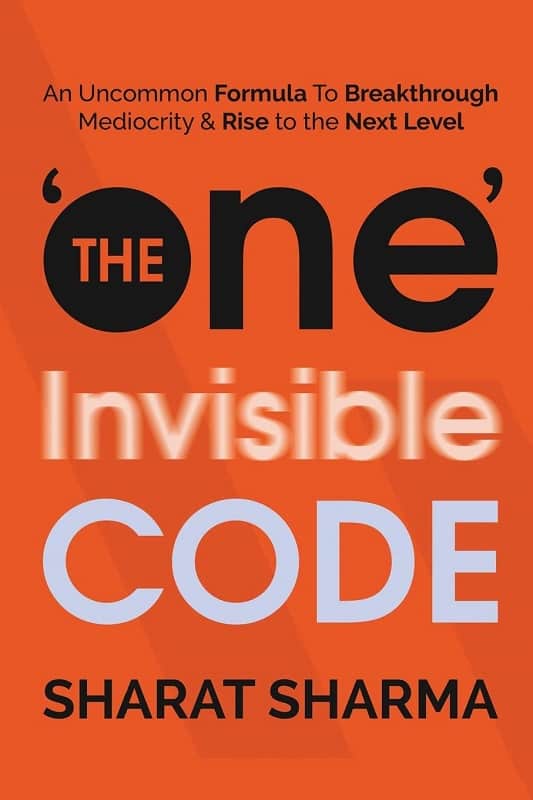Plot: 4/5
Characters:3.5/5
Writing Style: 4/5
Climax: 4/5
Entertainment Quotient: 5/5
“You will meet chaos and confusion on your path to clarity. Own this truth!”
– Sharat Sharma
As much as they say don’t judge a book by its cover, it’s a little difficult to follow this considering The One Invisible Code by Sharat Sharma. The book cover does not have graphics or pictorial representations like the inside of the book that is discreetly filled with black and white illustrations. But the typographical variations on the word ‘invisible’ on the cover is catchy and makes the reader immediately glued to know what lies inside.
Simple quotations are written in boxes throughout the book that mentions the key takeaways of the text. One can go back to the key advice on every other page by referring to these time and time again.
As the tag line to the book goes, this book claims to present some uncommon formulas to break through the mediocre living and rise and soar higher. The book totally lives up to this with its dedication to the dreamer within every reader.
That is the best part of the book. It not only acknowledges the dreams that we nurture but teaches us the importance of these dreams. In that, it does not belittle readers’ choices or thoughts but gives a friendly push to boost their confidence and self-esteem. It is how to go about the process of achieving these dreams that this book provides guidance and sheds light on through tips and tricks that are unconventional.
The book is divided into three parts. The first part comprises of three chapters, the second of two, and the third of five chapters. There is an additional chapter titled ‘My Story’ that gives a peek into the author’s own journey to being a brand in and of himself which includes being an entrepreneur, a performance coach, a high impact professional speaker, and now a best- selling author.
As the author states in the opening of this book: “The world bows to ones who believe in the power of their dreams,” it is the word power that is a game-changer in this quote. It is the power to dream and dream big without inhibitions that distinguishes a dreamer from a non-dreamer. The book states that the two important steps to becoming a dreamer are the first and the last. The first step is to dream and the last step is to never stop dreaming.
The beauty of the book is that it radiates so much hope and goodness that a reader is bound to feel uplifted. The message to the dreamer who has lost all hope is one such section. This makes the book almost like receiving a counseling session from someone not only well established and experienced but also someone who cares and understands. The optimism of the book is highly contagious.
The book invigorates, boosts morale, and gives awe-inspiring advice. From providing references to Osho, Steve Jobs, Muhammad Ali, Nelson Mandela to Tony Robbins, the book gives ample examples of individuals from history who have accepted challenges, grown through their struggles, seen difficulties but most important of all never given up.
The ‘One’ Invisible Code instills in the reader the spirit to fight back, to never lose calm in the face of calamity, and to not lose the vision of the goal. The language is easy to follow with sparsely used difficult vocabulary but a clean and neat writing style. The expressions are easygoing, nothing over the top and there is no use of jargon that makes the book accessible and quick to grasp.
The boxed style of noting down important bullet points is practiced throughout the book. This helps to recapitulate the thoughts in the chapters and emphasize the important ideas that the author wishes to drive home. There are boxes that intend to engage the reader and serves as an exercise book by asking questions and telling readers to jot down their thoughts and answers to those questions.
The ‘One’ Invisible Code is also highly organized, extremely meticulous in balancing the manner of relaying the tips. In that, it accepts that there are no shortcuts to reaching the goals. It reasserts that one must be practical and open-minded in accepting challenges. However, what this book fills are the mistakes that people tend to make.
The advice in this book seeks to help reduce those errors. Despite all the ups, the book does not refer much to women who have undertaken challenges and made it to the top except for the mention of a quotation by J.K. Rowling and Peggy O’Mara. Towards the end of the book, however, the author portrays the inspirational story of Kiran Bedi.
On the whole, the book is definitely worth the time as it presents some practical and reasonable tips that are bound to make readers inspired. It will be liked by those who are looking for self-help books that are not a mere repackaging of old ideas into a new format but provide worthwhile through relatable anecdotes.
Can’t wait to read it? Buy your copy of “The ‘One’ Invisible Code” using the link below
